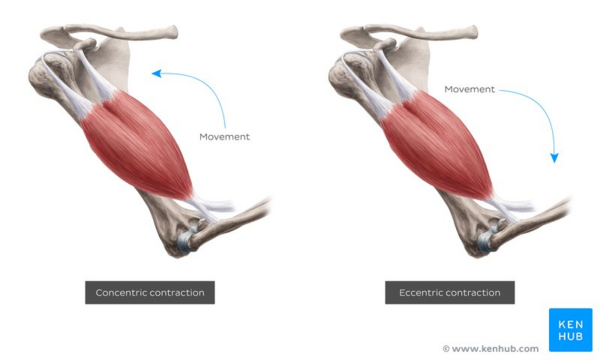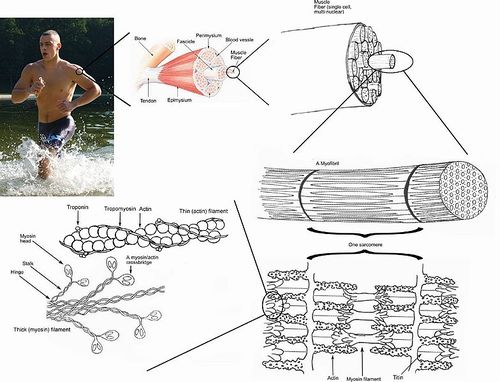Delayed onset muscle soreness (DOMS)
Introduction[edit | edit source]
Delayed onset muscle soreness (DOMS) also known as 'muscle fever'. It is a sore, aching, painful feeling in the muscles after unfamiliar and unaccustomed intense exercise. DOMS is thought to be due to temporary muscle damage and inflammation for which the most common trigger appears to be eccentric exercises. See Exercise induced muscle damage DOMS is considered a type 1 muscle strain injury that has a pain free period of 12-24 hours and muscle soreness peaks between 24-72 hours.[1]
Image: Overview of concentric vs eccentric muscle contraction[2]
Pathophysiology[edit | edit source]
Eccentric muscle contractions result in greater disruption to the structural elements of the muscle and connective tissue than concentric exercise,which is why DOMS is more intense with eccentric than concentric forms of activity[3]. This structural disruption has sufficient evidence by histologic studies, electron microscopic examinations and serum enzyme levels which have been carried out over the years.
Eccentric contractions recruit fewer motor units and thus the force generated is distributed over a smaller cross sectional area of the muscle.This increased tension per unit area causes greater injury to the tissue.However there is still ongoing research to establish a direct causation between the muscle and connective tissue injury to the onset of DOMS[4].
The onset of muscle soreness following exercise is multifaceted. The pain free period indicates that DOMS isn’t solely due to myofibrillar disruptions but has other underlying causes. The secondary injury model states that after the initial trauma (muscle damage or injury) the inflammatory cascade that follows can induce secondary damage[5][6].
Neutrophils and proinflammatory macrophages are important in the removal of cell debris through phagocytosis. However, excess production of reactive oxygen species (ROS) by these inflammatory cells can cause collateral damage to healthy cells that were not involved in the initial trauma by means of denaturing the proteins, lipids and nucleic acids that make up those cells[7][8][9].
Prevention[edit | edit source]
DOMS generally gets better on its own after a few days to a week.However, during that time range of motion and muscle performance can be reduced.There is some evidence that anti-inflammatory medications, massage[10], compression garments[11], rest [12]and some supplements can reduce the duration of DOMS[13][14].
Implications for Physical Therapy[edit | edit source]
Having DOMS is usually a positive sign post exercise. It indicates that the muscle is healing into a stronger state than it was before the activity and hence it means that the training was indeed effective.
Many physical therapy patients will be starting a new exercise program or will be adding new exercises to their current exercise program.These exercises may be intense for the patient and the patient may experience delayed onset muscle soreness (DOMS) after starting a physical therapy or exercise program. DOMS is usually weaker following subsequent exercise sessions but the first bout may be so intense that patients often refuse to continue the exercises.
Therefore, it is important for the therapist to reassure the patient that DOMS is a normal part of a new exercise program and to help the patient differentiate muscle soreness from other types of pain. It is also important to note that the severity of the soreness is not related to the extent of the exercise-induced muscle damage.[15]
Massage is one alternative therapy that has been proven to show significant effects in reducing the intensity of the stiffness and pain felt associated with DOMS. When administered within 2 hours of activity, the mechanical pressure is believed to decrease the neutrophil migration and thus reduce the inflammatory process within the muscle structure. Massage however was shown to have no effect on muscle performance or strength post exercise when compared to a control group who were not administered the therapy[16].
References[edit | edit source]
- ↑ Gulick D, Kimura I. Delayed Onset Muscle Soreness: What Is It and How Do We Treat It?. Journal of Sport Rehabilitation. 1996;5(3):234-243.
- ↑ Overview of concentric vs eccentric muscle contraction image - © Kenhub https://www.kenhub.com/en/library/anatomy/eccentric-muscle-contraction
- ↑ Basham SA, Waldman HS, Krings BM, Lamberth J, Smith JW, McAllister MJ. Effect of Curcumin Supplementation on Exercise-Induced Oxidative Stress, Inflammation, Muscle Damage, and Muscle Soreness. Journal of dietary supplements. 2019 Apr 26:1-4.
- ↑ Postexercise Muscle Soreness [Internet]. Sickle Cell Anemia Differential Diagnoses. 2017 [cited 2019Mar1]. Available from: https://emedicine.medscape.com/article/313267-overview#a5
- ↑ Toumi H. The inflammatory response: friend or enemy for muscle injury?. British Journal of Sports Medicine. 2003;37(4):284-286.
- ↑ Knight K, Brucker J, Stoneman P, Rubley M. Muscle Injury Management with Cryotherapy. Athletic Therapy Today. 2000;5(4):26-30.
- ↑ Bleakley C, Davison G. Cryotherapy and inflammation: evidence beyond the cardinal signs. Physical Therapy Reviews. 2010;15(6):430-435.
- ↑ Nguyen H, Tidball J. Interactions between neutrophils and macrophages promote macrophage killing of rat muscle cells in vitro. The Journal of Physiology. 2002;547(1):125-132.
- ↑ Powers S, Jackson M. Exercise-Induced Oxidative Stress: Cellular Mechanisms and Impact on Muscle Force Production. Physiological Reviews. 2008;88(4):1243-1276.
- ↑ Guo J, Li L, Gong Y, Zhu R, Xu J, Zou J, Chen X. Massage alleviates delayed onset muscle soreness after strenuous exercise: a systematic review and meta-analysis. Frontiers in physiology. 2017 Sep 27;8:747.
- ↑ Kim J, Kim J, Lee J. Effect of compression garments on delayed-onset muscle soreness and blood inflammatory markers after eccentric exercise: a randomized controlled trial. Journal of exercise rehabilitation. 2017 Oct;13(5):541.
- ↑ Song SH. Effects of rest interval following eccentric muscle contraction exercise on circulating substance, parameters related to damage and regeneration in skeletal muscle. The Official Journal of the Korean Academy of Kinesiology. 2013 Oct 31;15(4):107-15.
- ↑ Basham SA, Waldman HS, Krings BM, Lamberth J, Smith JW, McAllister MJ. Effect of Curcumin Supplementation on Exercise-Induced Oxidative Stress, Inflammation, Muscle Damage, and Muscle Soreness. Journal of dietary supplements. 2019 Apr 26:1-4.
- ↑ La Shier SV. Effect of Therapeutic Treatment on Delayed Onset Muscle Soreness (DOMS).
- ↑ Nosaka K, Newton M, Sacco P. Delayed‐onset muscle soreness does not reflect the magnitude of eccentric exercise‐induced muscle damage. Scandinavian journal of medicine & science in sports. 2002 Dec 1;12(6):337-46.
- ↑ 2. J E Hilbert, G A Sforzo, T Swensen. The effects of massage on delayed onset muscle soreness. Br J Sports Med 2003;37:72–75 ; (): . (accessed 18 February 2018).








